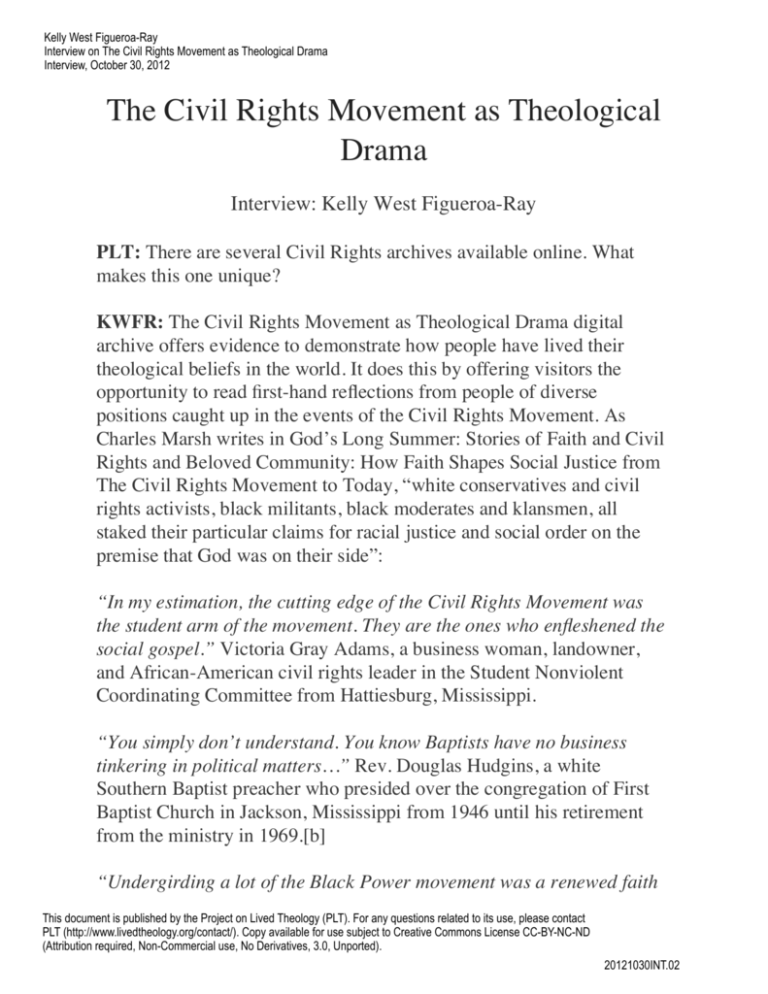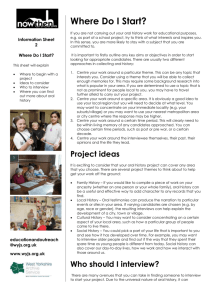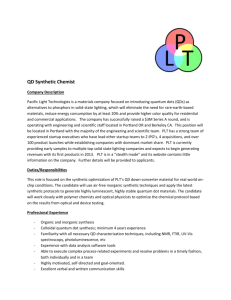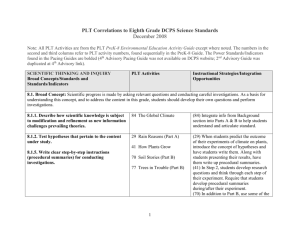File - The Project on Lived Theology
advertisement

Kelly West Figueroa-Ray Interview on The Civil Rights Movement as Theological Drama Interview, October 30, 2012 The Civil Rights Movement as Theological Drama Interview: Kelly West Figueroa-Ray PLT: There are several Civil Rights archives available online. What makes this one unique? KWFR: The Civil Rights Movement as Theological Drama digital archive offers evidence to demonstrate how people have lived their theological beliefs in the world. It does this by offering visitors the opportunity to read first-hand reflections from people of diverse positions caught up in the events of the Civil Rights Movement. As Charles Marsh writes in God’s Long Summer: Stories of Faith and Civil Rights and Beloved Community: How Faith Shapes Social Justice from The Civil Rights Movement to Today, “white conservatives and civil rights activists, black militants, black moderates and klansmen, all staked their particular claims for racial justice and social order on the premise that God was on their side”: “In my estimation, the cutting edge of the Civil Rights Movement was the student arm of the movement. They are the ones who enfleshened the social gospel.” Victoria Gray Adams, a business woman, landowner, and African-American civil rights leader in the Student Nonviolent Coordinating Committee from Hattiesburg, Mississippi. “You simply don’t understand. You know Baptists have no business tinkering in political matters…” Rev. Douglas Hudgins, a white Southern Baptist preacher who presided over the congregation of First Baptist Church in Jackson, Mississippi from 1946 until his retirement from the ministry in 1969.[b] “Undergirding a lot of the Black Power movement was a renewed faith This document is published by the Project on Lived Theology (PLT). For any questions related to its use, please contact PLT (http://www.livedtheology.org/contact/). Copy available for use subject to Creative Commons License CC-BY-NC-ND (Attribution required, Non-Commercial use, No Derivatives, 3.0, Unported). 20121030INT.02 and belief; a new set of role models for young men, a power to be different.” Cleveland Sellers, 1965 program director of the Student Nonviolent Coordinating Committee and early champion of the new racial spirituality and nationalistic consciousness called Black Power. “…I began to realize that perhaps it wasn’t God’s doings, but man’s. God didn’t turn them away from our churches–we did… God didn’t make ragged, hungry little boys pick rotten oranges and fruit out of the garbage can and eat them–we did.” Clarence Jordan, a white Southern Baptist New Testament Greek scholar, one of the founding members of Koinoina Farm in Americus, Georgia, and author of The Cotton Patch Gospel series. This site also provides full-length interviews and other primary materials free to the public for non-commercial, educational use, as well as access to a wealth of documentary evidence through detailed annotated bibliographic entries. On the site you can find reference types including but not limited to newspaper articles, field reports, letters, court filings, etc. This cohesive body of information demonstrates the struggles of peacemaking, community building, and lived theology during a pivotal moment in history. PLT: How do the categories of Actors, Scenes, and Themes interact and intersect? KWFR: These categories present the excerpted stories and reflections from three different lenses. Under Actors, viewers of the site will find all of the quotes and excerpts particular to each individual speaker. These quotes are then rearranged under the categories of Scenes and Themes. For example, if a particular actor, like Victoria Gray Adams, referenced in her reflection events that occurred during the 1964 Freedom Summer in Mississippi, the corresponding quote and excerpts would also show up under the Scene: “1964–The Crest of the Civil Rights Movement: Freedom Summer Successes and Fallout” and the Theme: “Activism: Personal Sacrifice, Community Organizing and Visions of a New Order.” This organization allows visitors to read the stories of each individual either as one body of work under the category of Actors, or in conversation with other individuals’ stories complied around various Scenes and Themes. These conversational views help bring into perspective the variety of beliefs, actions and experiences of the people included on this site. PLT: Who is the target audience? KWFR: Anyone who loves a good story is a target of this site. It provides quick and easy access to many voices of the Civil Rights Movement that have not yet been heard. In particular, people of faith will find interesting how activists, both pro- and anti-civil rights, as well as fence-sitting moderates[c], frame ideas about God and faith. Finally, we hope to reach students and researchers of all ages who would benefit from primary interview data, along with the annotated document entries of other primary source materials from the time period. PLT: What was the biggest challenge of this project, and what is your favorite component of the site? KWFR: The biggest challenge was to design a digital archive that would grant access to The Project on Lived Theology’s paper civil rights archive and to personal interviews conducted by Charles Marsh 1) without losing the valuable interview material among all of the primary source data and 2) without violating copyright laws. Additionally, it was important to organize the website in a way that was amenable to various types of research inquiries. In the end, I developed a two-tier system. The Actors, Scenes, and Themes sections showcase important interview data, while the Documents and Keywords features allow scholars to research primary documents found in the paper archive. The next big challenge was site construction. In the Fall of 2009, I applied and was granted status as a SHANTI (Sciences Humanities and Arts Network of Technological Initiatives) Cohort Fellow, which provided support from UVA staff to help construct the site. The design became a reality thanks to Rafael Alvarado, Associate Director of SHANTI, and Mark Edwards of Optipop. As a team, we debated the best way to construct this new type of site and ultimately decided to use Drupal for our content management system, because its use of nodes allows for the rearranging of material under a variety of headings, as described above. Rafael constructed the site in partnership with me and Mark, who was in charge of aesthetics. In less than a year, The Civil Rights as Theological Drama Digital Archive was up and running. The successful result is due to this team collaboration. In terms of favorite features, I love that at a click you can get a glimpse into vastly different views of reality and faith from people who lived or worked in close proximity in the South between 1955 and 1973. Also as a researcher, I love to have access to primary sources otherwise dispersed among the thousands of boxes in paper archives all over the country. Here on this site, these otherwise obscure documents are not only accessible, but also categorized by keyword. Even if researchers do not know what documents to look for, by clicking on a keyword they can browse through documents related to a particular topic, time, place, person, etc. I love that scholars in the future will have access to evidence that will drive new questions and provide new insights into one of the most important times in our nation’s history.








